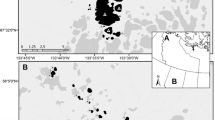Abstract
Waterfowl that eat macroinvertebrates must select among potential nesting or brood-rearing habitats that may vary in food abundance over the season. We compared the reliability of predicting the relative abundance of macroinvertebrates in boreal wetlands using either the number of macroinvertebrates collected at one sampling period, or presence or absence of fish. Wetlands with fish had fewer macroinvertebrates than fishless wetlands in all five sampling periods. Predictions of the relative abundance of invertebrates in a wetland at other sampling periods based on the presence or absence of fish, were equal to or better than predictions based on the actual number of macroinvertebrates collected during one sampling period. These results suggest that fish status of a wetland is a reliable cue to invertebrate abundance in boreal wetlands.
Similar content being viewed by others
References
Bendell, B. E., 1986. The effects of fish and pH on the distribution and abundance of backswimmers (Hemiptera: Notonectidae). Can. J. Zool. 64: 2696–2699.
Bendell, B. E. & D. K. McNicol, 1987. Fish predation, lake acidity and the composition of aquatic insect assemblages. Hydrobiologia 150: 193–202.
Blancher, P. J. & D. K. McNicol, 1986. Investigations into the effects of acid precipitation on wetland-dwelling wildlife in northeastern Ontario. Can. Wildl. Serv. tech. Rep. Ser. No. 2.
Blancher, P. J. & D. K. McNicol, 1987. Peatland water chemistry in central Ontario in relation to acid deposition. Wat. Air Soil Pollut. 35: 217–232.
Campbell, P. G. C. & P. M. Stokes, 1985. Acidification and toxicity of metals to aquatic biota. Can. J. Fish. aquat. Sci. 42: 2034–2049.
Davis, W. J., 1982. Territory size in Megaceryle alcyon along a stream habitat. Auk 99: 353–362.
DesGranges, J.-L. & M. L. Hunter Jr., 1987. Duckling responses to lake acidification. Trans. n. am. Wildl. nat. Resour. Conf. 52: 636–644.
Eadie, J. McA. & A. Keast, 1982. Do goldeneyes and perch compete for food? Oecologia 55: 225–230.
Eriksson, M. O. G., 1978. Lake selection by goldeneye ducklings in relation to the abundance of food. Wildfowl 29: 81–85.
Eriksson, M. O. G., 1979. Competition between freshwater fish and goldeneyes Bucephala clangula (L.) for common prey. Oecologia 41: 99–107.
Eriksson, M. O. G., 1983. The role of fish in the selection of lakes by nonpiscivorous ducks: mallard, teal and goldeneye. Wildfowl 34: 27–32.
Eriksson, M. O. G., L. Henrikson, B.-I. Nilsson, G. Nyman, H. C. Oscarson, A. E. Stenson & K. Larsson, 1980. Predator-prey relations important for the biotic changes in acidified lakes. Ambio 9: 248–249.
Evans, R. A., 1989. Response of limnetic insect populations of two acidic, fishless lakes to liming and brook trout (Salvelinus fontinalis). Can. J. Fish. aquat. Sci. 46: 342–351.
Hunter, M. L. Jr, J. J. Jones, K. E. Gibbs & J. R. Moring, 1986. Duckling responses to lake acidification: do black ducks and fish compete? Oikos 47: 26–32.
Joyner, D. E., 1980. Influence of invertebrates on pond selection by ducks in Ontario. J. wildl. Manage. 44: 700–705.
Macan, T. T., 1965. Predation as a factor in the ecology of waterbugs. J. anim. Ecol. 34: 691–698.
Mallory, M. L., 1991. Acid precipitation, female quality, and parental investment of common goldeneyes. M.Sc. thesis, Carleton University, Ottawa, Ontario, Canada.
Mallory, M. L., P. J. Weatherhead, D. K. McNicol & M. E. Wayland, 1993. Nest site selection by common goldeneyes in response to habitat features influenced by acid precipitation. Ornis Scan. 24: 59–64.
McNicol, D. K., B. E. Bendell & R. K. Ross, 1987. Studies on the effects of acidification on aquatic wildlife in Canada: waterfowl and trophic relationships in small lakes in northern Ontario. Can. Wildl. Serv. occas. Pap. No. 62.
McNicol, D. K. & M. E. Wayland, 1992. Distribution of waterfowl broods in Sudbury area lakes in relation to fish, macroinvertebrates and water chemistry. Can. J. Fish. aquat. Sci. 49(Suppl. 1): 122–133.
Morin, P. J., 1984. Odonate guild composition: experiments with colonization history and fish predation. Ecology 65: 1866–1873.
Oscarson, H. G., 1987. Habitat segregation in a water boatman (Corixidae) assemblage — the role of predation. Oikos 49: 133–140.
Pehrsson, O., 1984. Relationships of food to spatial and temporal breeding strategies of mallards in Sweden. J. wildl. Manage. 48: 322–339.
Pope, G. F., J. C. H. Carter & G. Power, 1973. The influence of fish on the distribution of Chaoborus spp. (Diptera) and density of larvae in the Matamek River system, Quebec. Trans. am. Fish. Soc. 102: 707–714.
Post, J. R. & D. Cucin, 1984. Changes in the benthic community of a small precambrian lake following the introduction of yellow perch, Perca flavescens. Can. J. Fish. aquat. Sci. 41: 1496–1501.
Resh, V. H. & D. M. Rosenberg, 1989. Spatial-temporal variability and the study of aquatic insects. Can. Ent. 121: 941–963.
Stenson, J. A. E., T. Bohlin, L. Henrikson, B. I. Nilsson, H. G. Nyman, H. G. Oscarson & P. Larsson, 1978. Effects of fish removal from a small lake. Verh. int. Ver. Limnol. 20: 794–801.
Author information
Authors and Affiliations
Rights and permissions
About this article
Cite this article
Mallory, M.L., Blancher, P.J., Weatherhead, P.J. et al. Presence or absence of fish as a cue to macroinvertebrate abundance in boreal wetlands. Hydrobiologia 279, 345–351 (1994). https://doi.org/10.1007/BF00027866
Issue Date:
DOI: https://doi.org/10.1007/BF00027866




